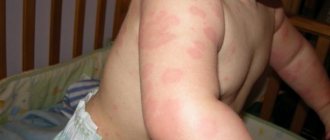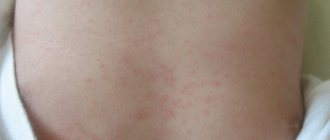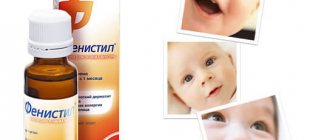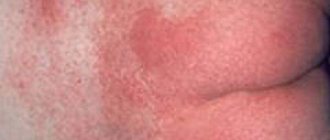The sun - we wait so long for its arrival after a cold winter, and we are so sad when clouds cover the sky. Warmth, vitamin D, an even tan and a great mood - it would seem that we get all the best from the sun. But not always. There are many people (about 20% of the planet's population) for whom the sun is dangerous. These are allergy sufferers.
Sun allergies, or photodermatoses, are divided into several groups, depending on the factors causing the disease. There are phototoxic, photoallergic, hereditary and other photodermatoses.
Causes of sun allergies
Although the exact cause of this condition is not fully known, it is believed that ultraviolet radiation from the sun or artificial sources such as solar lamps causes a reaction in some people who are sensitive to this type of light. This causes an immune reaction that results in a rash.
Risk factors for some types of rash may include:
- Female;
- Light skin;
- Hereditary predisposition.
Principles of treatment in infants and children over 1 year of age
If you have urticaria, you will not only need to provide first aid - you will definitely need to consult with specialists who will not only help you get rid of the symptoms, but also identify and eliminate the cause of the allergy.
First aid
First aid should be provided when the child shows the first signs of an allergic reaction. If a rash appears on the baby’s body, redness occurs, he complains of general malaise and headache, or feels sick, then parents should take action immediately. Basic rules for providing first aid for ultraviolet allergies for children of any age:
- eliminate contact with the allergen (in this case, urgently move the child to a shaded place where direct sunlight does not penetrate);
- wet a cotton napkin in clean water (if possible, it is recommended to replace water with a decoction of calendula, chamomile or green tea), apply to the affected areas;
- Allergy to ultraviolet radiation is often accompanied by dehydration, which is especially dangerous for the youngest patients, so the child should drink a lot - it is recommended that older children be offered mineral water acidified with lemon juice;
- If an allergic reaction occurs in an infant, you should immediately seek medical help.
Antihistamines
Antihistamine medications can only be prescribed by a doctor. You cannot select a medicine yourself, based on advertising or recommendations from relatives and friends, especially when it comes to an infant. Before using antihistamines, you should consult not only your pediatrician, but also an allergist.
| A drug | Release form | Age restrictions |
| Suprastinex | Pills | From 6 years old |
| Drops | From 2 years | |
| Fenkarol for children | Pills | |
| Powder for preparing a drinking solution | ||
| Desloratadine | Pills | From 12 years old |
| Loratadine | Pills | From 2 years (children aged 2 years and older weighing less than 30 kg are recommended to take in syrup form) |
| Syrup | ||
| Astemizole | Pills | From 2 years |
| Suprastin | Pills | From 3 years |
| Water solution | Contraindicated in newborns |
Antihistamine drug Suprastin
Local preparations
Local medications help relieve swelling, relieve the child from itching, burning and other painful sensations. These are gels, creams or ointments that are applied directly to the damaged area of the skin and have an anti-inflammatory, antibacterial, antipruritic and regenerating effect. The most popular topical agents include:
- Desitin – cream and ointment. It has a complex effect - antiseptic, adsorbent, anti-inflammatory, drying agent. Can be used in the treatment of children of any age.
- Wundehil ointment. The product, consisting of natural ingredients, has a tonic and regenerating effect. Has no age restrictions.
- Cream Gistan. A drug based on a synthetic glucocorticosteroid. Contraindicated for children under two years of age.
ethnoscience
An allergy to ultraviolet light is accompanied by very unpleasant and painful symptoms. After preliminary consultation with a specialist, it is permissible to supplement the prescribed course of therapy (including medication) with traditional medicine.
If you are allergic to the sun, traditional medicine advises drinking immunostimulating teas
The list of effective home recipes includes the following:
- Mix nettle, cocklebur herb, calamus root, dried or fresh. Pour 2 tbsp. mixture of herbs with a liter of boiling water, boil over medium heat for five minutes. Take a third of a glass twice a day before meals. The product relieves inflammation, cleanses the blood, and helps strengthen natural immunity.
- Grind the celery root in a blender or finely chop it with a ceramic knife. Squeeze out the juice. Use the resulting liquid to lubricate the affected areas of the skin.
- Grate fresh potatoes or cucumber. Apply the resulting paste to the affected areas for half an hour.
- Mix valerian root, St. John's wort, string, chamomile, sage and celandine. You need to take two tablespoons of each of the medicinal herbs. Pour 1.5 liters of boiling water, boil for 5 minutes. Leave for an hour. Add to bath before bathing.
Symptoms of sun allergy
This condition usually develops 30 minutes or more after exposure to the sun.
Characteristics of the rash vary and include:
- Groups of small papules or blisters;
- Itchy red spots;
- Hyperemic areas of skin;
- Raised or rough areas of skin.
If a person receives a severe sunburn, it may be accompanied by nausea and fever.
A person with a sun allergy may also experience weakness, breathing problems, headaches, and other allergy symptoms.
Manifestations can occur anywhere on the body exposed to sunlight.
Some types of rashes occur on skin that is usually covered by clothing, such as the chest or arms.
Doctor, is this forever?
Treatment of sun allergies involves eliminating exposure to ultraviolet radiation. In the case of solar urticaria, antihistamines help, and there are special medications that thicken the skin and reduce its sensitivity to sunlight. Treatment in this case consists of gradually accustoming the skin to the sun while taking medication.
To relieve exacerbation of photodermatitis, local treatment is prescribed in the form of ointments, sometimes hormonal, and internal treatment: vitamins B, E, C, nicotinic acid, non-steroidal anti-inflammatory and antihistamines. Usually the course of treatment continues for several days or weeks. During this time, it is recommended to spend less time in the sun, wear a wide-brimmed hat, clothes with sleeves and sunglasses.
If sun allergy is left untreated, repeated episodes will lead to the development of photodermatosis. When you have managed to stop the allergy attack by carefully taking care of protecting your skin, eliminating provoking factors and strictly following the sunbathing regime, you have the opportunity to bask in the gentle rays. Sun allergies can be controlled and prevented, and children may even outgrow this disease.
medkrug.ru
Treatment of sun allergies in Samara at the FIRST NEUROLOGY clinic
Allergies do not always require treatment, as they often go away on their own within 10-14 days. This depends on the type of rash, as well as on the overall clinical picture.
However, if the rash is itchy, a hydrocortisone steroid cream may be helpful, as may oral antihistamines. Cold compresses or a cool bath can also relieve itching. If you cannot cope with your allergies, contact an allergist-immunologist at the FIRST NEUROLOGY clinic at the address: Samara, st. Stara Zagora 142 B.
Administrator's phone number
How to protect your baby?
To protect your baby from photodermatoses, you must follow the following recommendations:
- You need to introduce your child to the sun gradually. The more gradually the skin gets used to the sun's rays, the less likely it is that an allergy will occur. The first sunbathing should be no more than 5-10 minutes.
- Protect your baby's skin with clothing (be sure to use a hat) and sunscreens that are approved for children under one year of age. Creams based on mineral filters with a high level of protection are considered the safest. Apply them to the baby's skin 30 minutes before going outside. Even on cloudy days, solar radiation has an impact on the skin.
- Avoid walking when the rays are most aggressive - this is from 10 a.m. to 2 p.m.
- Try to spend more time in the shade. This is safer - this way the baby can get more benefits from the sun than harm.
- Minimize the consumption of products that increase skin sensitivity.
- Do not use medications for mother and child without a doctor’s prescription.
- Carefully monitor the baby's health.
- Maintain a sleep-wake schedule.
- Parents should avoid bad habits.
- Spend more time with your baby in environmentally friendly conditions.
- For mothers who are breastfeeding, carefully monitor their diet. Nutrition must be correct and balanced.
- Introduce complementary feeding and supplementary feeding in accordance with age.
- Minimize the use of detergents. For a baby, bathing with soap or shampoo once a week is necessary and sufficient. The rest of the time, pediatricians advise using clean water or herbal decoctions.
An allergy to the sun in an infant is certainly a dangerous condition. But an alert mother will always be able to recognize the symptoms at the initial stage. Timely and correct treatment will avoid possible complications.
It must be remembered that the damage caused by the sun is cumulative. And in order for your child to avoid sun damage in adulthood, you need to take care of his safe contact with the sun's rays in childhood.
Read also
What is the difference between urticaria and Quincke's edema?
What is the difference between urticaria and Quincke's edema? Quincke's edema is a form of edema in the deep part of the inner layer of the skin and below, which is a life-threatening condition.
In some cases this... Read more
Food allergies
What is the difference between food allergy and food intolerance? Food allergy is the response of the immune system to the intake of a particular food that causes an allergic reaction. Even a small amount of associated...
More details
Allergic dermatitis
What is allergic contact dermatitis? Anyone has ever experienced skin symptoms after using various skin care products, shower gel or shampoo. Such…
More details
Drug allergy
What is a drug allergy? A drug allergy is an abnormal reaction of the immune system to medications. Any medicine—over-the-counter, prescription, or herbal—can cause this condition. However,…
More details
Relevance of allergies in children
When it comes to chronic health problems in children, allergies top the list. Allergies can cause pathological conditions of varying severity in children. Causes of allergies...
More details
And remember about prevention!
An allergy to the sun is not a reason to deprive yourself of sunlight and warmth. The best protection against photodermatosis is proper prevention. To get started, you can remember and adhere to a few simple rules:
- Go outside or go to the beach only with a protective cream with SPF +30-50.
- Sunbathe either before 12.00 or after 16.00 for no more than 2-3 hours in a row.
- Use any cosmetics as little as possible and drink at least 1.5-2 liters of clean water every day.
- Stay away from any photosensitizers - we have listed them in the article.
- Upon returning from the beach/outside, immediately take a shower and do not use deodorants or perfume.
Causes
Contrary to public opinion, the sun's rays do not act as allergens. Pathology appears as a result of exposure to photosensitizers. They increase the skin's sensitivity to radiation. Under their influence, free radicals are released that come into contact with proteins. The result of this is the formation of new compounds. It is these compounds that are the activators of allergies on the face in the sun.
Taking into account the types of photosensitizers, the main causes of pathology are identified. These include:
- use of external preparations (ointments, gels, etc.);
- skin contact with household chemicals;
- cosmetic products of a specific group;
- Allergies may occur due to exposure to plant juices and herbs.
In some cases, facial allergies to the sun appear as a result of the accumulation of specific components in the body. This may occur due to metabolic disorders, as well as diseases that negatively affect the elimination of toxic substances.
Most often, people with fair skin suffer from facial allergies due to the spring sun. The risk group includes pregnant women and those people who often visit solariums.
Harmful tanning for children
I remember how, as a child, my brother and I ran to the sea. One of our goals was to get a chocolate tan. Now it’s strange for me, but then it really seemed like it was cool to sunbathe until you were black. We climbed into the dunes of the Baltic coast, lay down directly on the hot sand and exposed our pale skin after winter, phototype No. 3 according to Fitzpatrick, to the scorching rays of the midday July sun.
And despite the third phototype, which is much more resistant to the sun than the first two, we inevitably received burns. True, it didn’t get to the point of blisters, but it was painful, the skin turned red and soon, to our deep disappointment, it peeled off along with the tan, leaving ugly pale pink spots on the tanned body.








